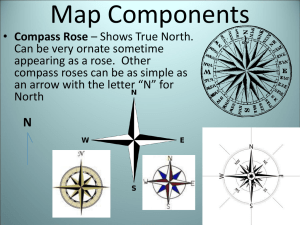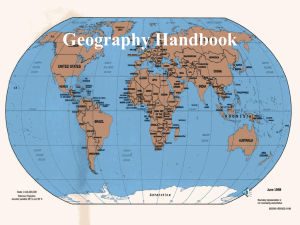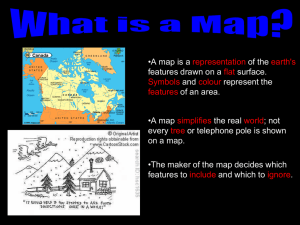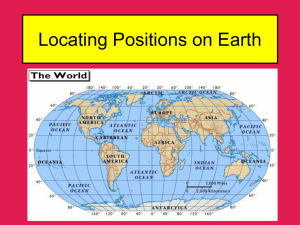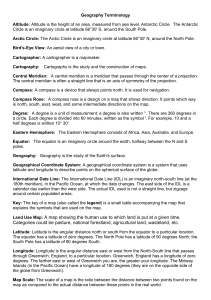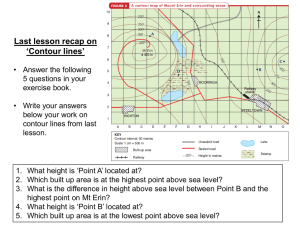A Geographer`s Tools
advertisement
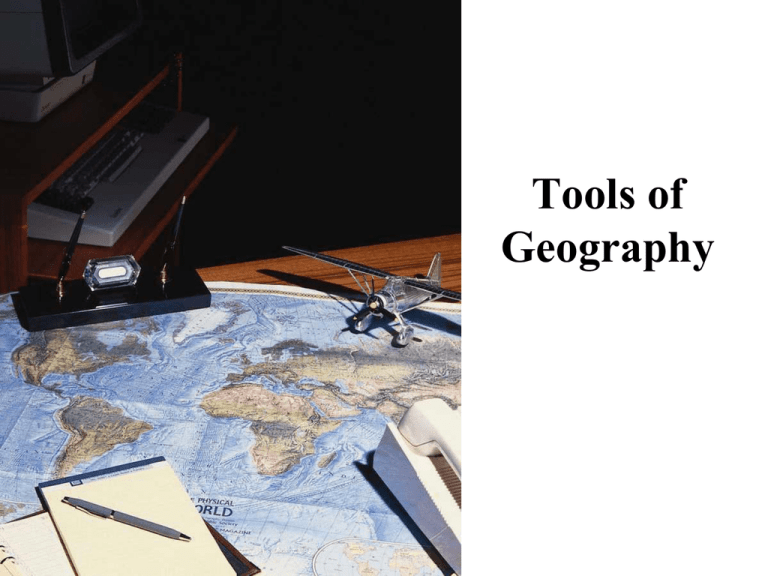
Tools of Geography I. Geography Terms A. Absolute location: the precise point where a place is located on Earth B. Distortion: a change in the shape, size, or position of a place when it is shown on a map C. Map Projection: a way of representing the spherical Earth on a flat surface D. Relative Location: where a place is located in relation to another place II. Geographic Setting A. Locating Things on Earth: The Main Purpose of Maps A. Locating Things on Earth 1. Absolute location: the exact point on the globe which requires two coordinates (latitude/longitude or address/street) 2. Relative location: the location of a place based on other known places (what is north or south or next to a place). B. Distortion: The Big Problem 1. Because maps are two-dimensional and the Earth is three-dimensional, any flat map will be distorted. 2. Globes are the best representation of the Earth. 3. All flat maps have some level of distortion (size, shape, or distance). III. Map Titles and Symbols A. B. C. D. The Title Tells What a Map Shows A Compass Rose Shows Directions on a Map A Legend Identifies Symbols on a Map A Grid Organizes Space on a Map A. The Title Tells What a Map Shows » Political Boundaries » Agriculture, etc. B. A Compass Rose Shows Directions on a Map • 1. Cardinal directions (north, south, east, and west) • 2. Intermediate directions (northeast, southeast, southwest, and northwest). C. A Legend Identifies Symbols on a Map » 1. Symbols are placed in a box on a map called a map legend or map key. A Legend Identifies Symbols on a Map • 2. Symbols may be color – blue = water; – green = grasslands; – brown = mountains • or shapes —star = capital; —miniature airplanes = airports; —box = building). D. A Grid Organizes Space on a Map • 1. A map grid is a set of imaginary lines that divide up space on maps. • 2. The lines are labeled with letters and numbers (A9 or C3). A Grid Organizes Space on a Map • 3. The global grid is a system that uses latitude and longitude. IV. The Global Grid: Longitude and Latitude A. Lines of Latitude Parallel the Equator 1. They run east and west around the globe. 2. The equator is exactly midway between the North and South poles a) North Pole is 90 degrees N., South Pole is 90 degrees S. b) Each degree is approximately 69 miles 3. Other parallels are measured from the Equator. B. Lines of Longitude Run from Pole to Pole 1. They are also called meridian lines (half circles). 2. They run north to south 3. The Prime Meridian runs through Greenwich, England and is 0 degrees. 4. Other lines are measured from the Prime Meridian. 5. International Date Line runs through the Pacific Ocean, ½ ways around the world from the Prime Meridian. When you cross over this, you are in a different day (west = forward 1 day, east = go back a day). C. Latitude and Longitude Mark Absolute Location. 1. To get an absolute location, there must be two points or coordinates. 2. The meeting of the latitude and longitude lines is the absolute location. Stop On the bottom of the first page please summarize the material that has been covered in this presentation V. Dealing with Distances: Map Scale (How Scale Affects Details Estimating Distance with a Map Scale) A. How Scale Affects Details 1. Large scale = close up view of a small area with a lot of detail. 2. Small scale = larger area with few details. • B. Estimating Distance with a Map Scale – 1. The map scale is found on the map and tells how many inches equal a specific distance on the map (one inch equals 100 miles). – 2. Use a piece of paper and mark the scale notches on paper and label the marks with the number of miles or kilometers, and then line it up on the map VI. Hemispheres, Continents, and Oceans • A. A Hemisphere is Half a World – 1. The equator divides the world into the Northern and Southern Hemispheres. – 2. The Prime Meridian divides the world into the Eastern and Western Hemispheres. B. Continents and Oceans Cover Earth 1. There are seven continents a) b) c) d) e) f) g) Asia Africa North America South America Antarctica Europe Australia 2. There are four oceans a) b) c) d) Atlantic Pacific Indian Arctic VII. Earth and Sun A. The Moving Earth 1. The Earth moves around the sun in a nearly circular path called an orbit. One round trip is called a revolution and takes 365 ¼ days = one year. A. The Moving Earth 2. The Earth spins on an imaginary line that passes through the North and South Poles and through the center of the Earth, called the axis. A. The Moving Earth 3. Rotation is one spin of Earth on its axis and takes one day or 24 hours. 4. The Earth spins from west to east. B. Earth’s Tilt Creates the Seasons 1. Earth is at a 23 ½ degree tilt in relation to the sun causing the Northern and Southern hemispheres to receive different amounts of sunlight which creates seasons. B. Earth’s Tilt Creates the Seasons 2. Summer in the N. hemisphere is when the N. hemisphere is tilted toward the sun, getting more light or direct sun rays on the Tropic of Cancer. B. Earth’s Tilt Creates the Seasons 3. Winter in the N. hemisphere is when the N. hemisphere is tilted away from the sun, getting less direct light. The direct light is on the Tropic of Capricorn. 4. Seasons are opposite in the two hemispheres. C. Tropics, Circles, and Zones 1. Tropic of Cancer is 23 ½ degrees north. 2. Tropic of Capricorn is 23 ½ degrees south 3. Tropical Zone is between these two. There is much light, heat, and rain. There are no winters. • 4. Arctic Circle and Antarctic Circle = the sun doesn’t shine at all on one day each year. • 5. Polar zone = the area between the Circle and the pole = little sunshine and very cold. • 6. Temperate zone = between the Tropic and polar zone = summers are warm, winters are cold. VIII. Showing a Round World on a Flat Map A. All Flat maps have distortion Map 1. All Flat maps have distortion Robinson Projection (popular) = balances distortion of size and shape = fairly accurate. Lambert Projections shows polar areas that other maps distort. Mercator Projections show direction but distort size. Eckert IV Projections show size but distort shape. Goode’s Homolosine Projections show continents but distort oceans. B. The best representation of the Earth is the Globe. At the bottom of the page provide a 3 sentence summary of the material covered





